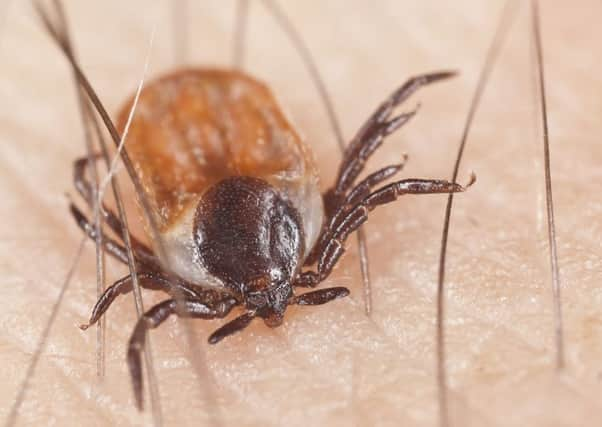Conservation can increase Lyme disease threat, studies show


The blood-sucking arachnids, which are related to spiders and scorpions, can carry the microbes that cause Lyme disease.
Studies show managing the environment to protect wildlife and maximise biodiversity has many positive effects, including benefits for human health and well-being from spending time in nature.
Advertisement
Hide AdAdvertisement
Hide AdHowever, scientists have now discovered that factors such as high deer populations and forest planting schemes can increase the number of ticks in an area, therefore raising the danger of Lyme disease for dog-walkers, cyclists and ramblers.
The findings have sparked calls for the knock-on effects on disease carriers such as ticks and mosquitoes to be considered when drawing up conservation plans.
The studies, led by the University of Glasgow in collaboration with Scottish Natural Heritage (SNH), the James Hutton Institute and Public Health England, examined the impact of conservation measures on tick numbers, wildlife host communities and transmission of Borrelia bacteria.
Lead author Dr Caroline Millins, from the University of Glasgow, said: “We identified several widespread conservation management practices which could affect Lyme disease risk: the management of deer populations, woodland regeneration, urban greening and control of invasive species.
“We found that some management activities could lead to an increased risk of Lyme disease by increasing the habitat available for wildlife hosts and the tick vector.
“These activities were woodland regeneration and biodiversity policies, which increase the amount of forest bordering open areas, as well as urban greening.
“However, if deer populations are managed alongside woodland regeneration projects, this can reduce tick populations and the risk of Lyme disease.”
Deer are often key to maintaining tick populations, but do not become infected with the bacteria.
Advertisement
Hide AdAdvertisement
Hide AdPrevious work by co-researcher Lucy Gilbert, from the James Hutton Institute, has shown that dramatically reducing deer herds through special fencing or culling can cut tick numbers and therefore the chances of spreading Lyme disease.
“Widespread management activities can potentially teach us a lot about how changes to the environment can affect the chances of humans coming into contact with ticks and with the pathogens ticks transmit,” said senior author Dr Roman Biek, also from the University of Glasgow.
“We recommend that monitoring ticks and pathogens should accompany conservation measures such as woodland regeneration and urban greening projects.
“This will allow appropriate guidelines and mitigation strategies to be developed, while also helping us to better understand the processes leading to higher Lyme disease risk.”
Professor Des Thompson, principal adviser on science and biodiversity at SNH, also worked on the studies.
He added: “This is the sort of vital research we need to act on in order to advise government on the best practices for enhancing wildlife whilst minimising risks to human health.
“The Scottish Government’s 2020 plan for Scotland’s Biodiversity requires this integrated approach, bringing human health and wildlife management sectors together.”
Lyme disease can be treated with antibiotics if caught early, but many sufferers experience lifelong effects.
Advertisement
Hide AdAdvertisement
Hide AdA common early sign is an expanding skin rash around the site of a tick bite. Other indicators are less specific but can include headaches, flu-type symptoms and aching joints.
The paper has been published in the journal Philosophical Transactions of the Royal Society B.